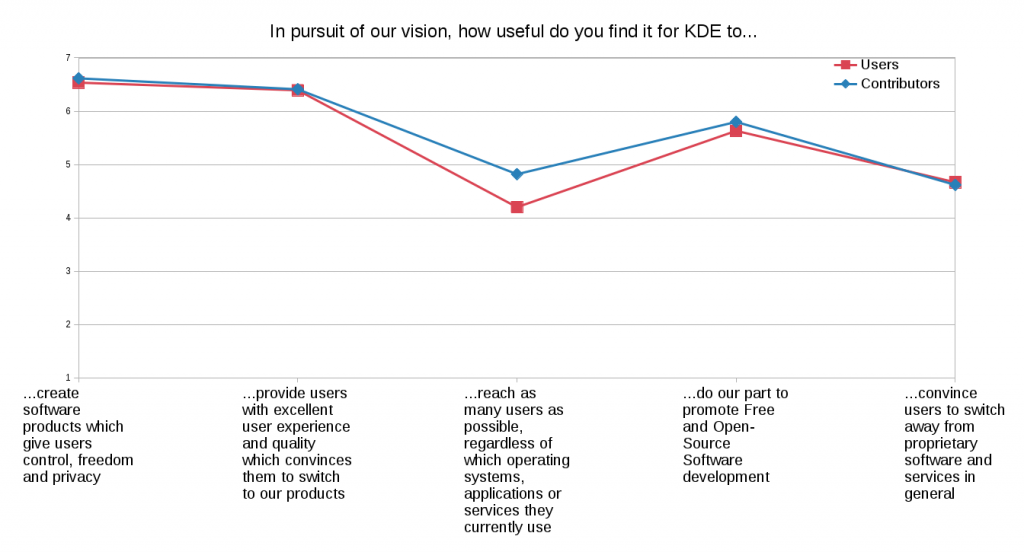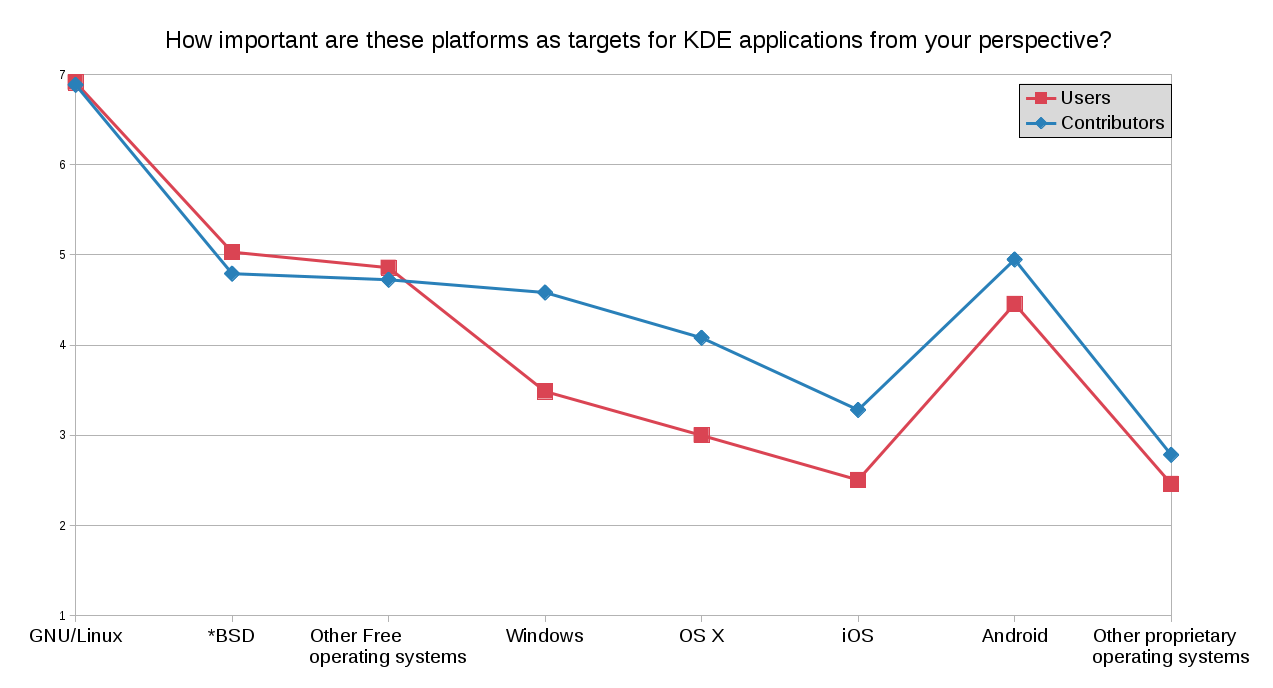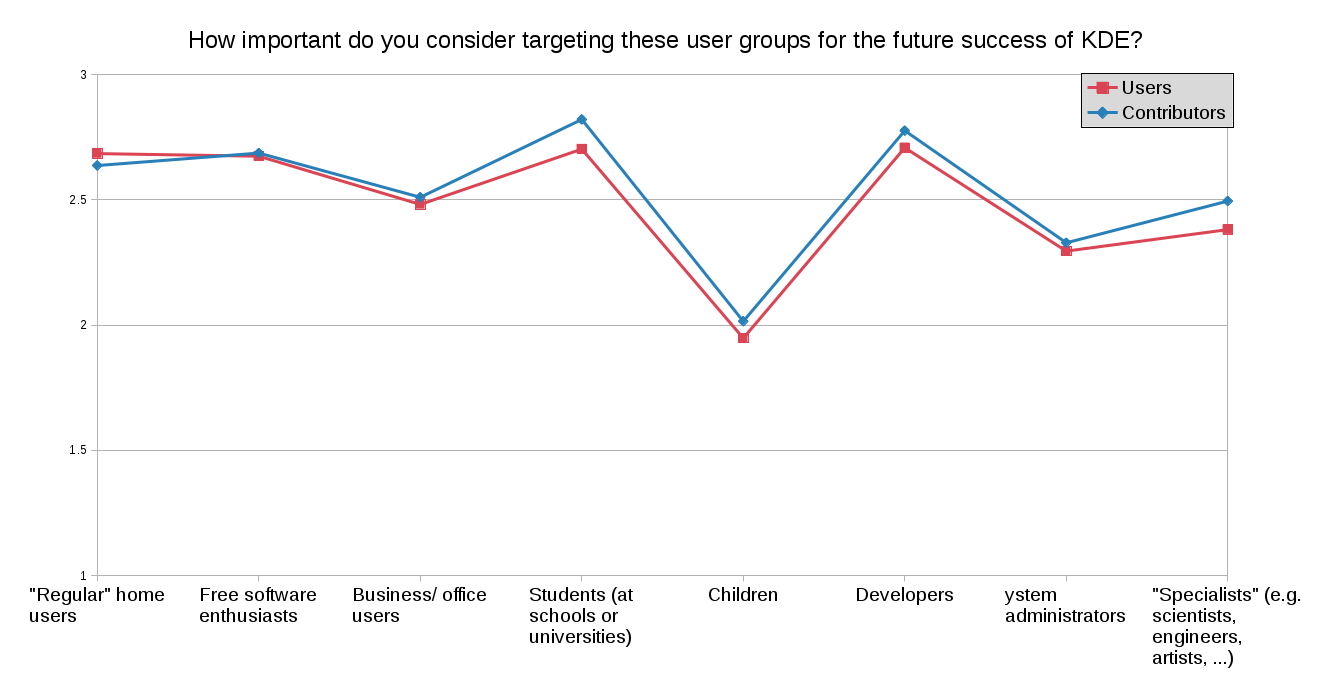
Retrospective: The KDE Mission Survey
It might sound a bit weird that I’m now talking about something that took place two years ago, but I just realized that while the call to participate in the survey for the KDE Mission was published on the Dot, the results have so far not received their own article.
People who have participated in the survey but don’t read the Community list might have missed the results, which would be a pity. Therefore, I’d like to offer a bit of a retrospective on how the survey came to be and what came out of it.
The Backstory
To recap a bit on what lead to the survey: After we had finally arrived at a shared Vision statement for KDE in April 2016, the next step was to distill the more high-level Vision into a more concrete Mission statement. We started brainstorming content for the Mission in our Wiki, but soon realized that there were diverging viewpoints on some issues and the relatively small group discussing them directly on the mailing list wasn’t sure which viewpoint represented the majority of the KDE community.
We also wanted to know what our users care about the most. Although in the end it’s the community who defines our Mission, we don’t make software just for ourselves, so we hoped that our goals would align with those of our users.
The Survey
To find out what is most important to the community at large as well as our users, I applied one of the standard tools in my belt: An online survey, in which participants indicated their perceived importance of goals that were brought up in the brainstorming, as well as the perceived usefulness of several measures towards achieving each goal. They also gave their opinion on a few of the contending viewpoints from the brainstorming, as well as on the importance of certain target audiences and platforms.
A few demographic questions, such as whether participants identified as users of or contributors to KDE software, how long they had been using and contributing to KDE software, as well as in which area they contribute or whether they do it as part of their job, aimed at making sure that our sample isn’t skewed toward certain groups.
We invited participants via the aforementioned Dot article, several big KDE mailing lists as well as Google+ (where we have a pretty lively community).
Analysis
I ran series of one-sample t-tests (with Benferroni correction) to check whether the sample averages for the importance ratings were significantly different from the scale mid-point (4 on a 7-point scale). I did that instead of a within-subjects ANOVA because we cared about whether each goal or means was above- or below-averagely important to the KDE community more than than about how they compared to each other.
Furthermore I compared the two variables representing both sides in each case of contending viewpoints using a paired-sample t-test.
Results
Sample
We had 201 currently or formerly active KDE contributors participating in the survey, as well as 1184 interested users.
Demographics showed that no particular group of people dominated our sample in any of our demographical variables (other then users vs. contributors, which were analyzed separately anyway).
Some result highlights
I will only report a few interesting highlights in this post, please see the full report here for all results. If you want to do your own analysis, you can find all data here.

The importance of the goals turned out to be quite similar between contributors and users, with creating software products which give users control, freedom and privacy, as well as providing users with excellent user experience and quality being the most important for both groups. Contributors rated all goals’ importance as significantly above the scale midpoint. The biggest difference between users and contributors is on whether we should reach as many users as possible, with users rating it much lower than contributors. This is to be expected, as current users naturally don’t care much about whether we try to reach other users.
Regarding the contending viewpoints within the brainstorming group, the survey showed a statistically significant preference among the KDE community at large for one of the viewpoints in three out of four cases: On average, the community shows a preference for focusing on applications covering our users’ most common tasks, for covering GUI applications as well as non-GUI applications, and for focusing on Qt. The community seems largely indifferent about whether we should strive for consistency between KDE GUIs across platforms, or for adherence to specific platform guidelines.
When it comes to which operating systems we should target, GNU/Linux is still preferred by a large margin, followed by Android according to our contributors, and by *BSD and other Free operating systems according to our users. There was a big difference in perceived importance of Windows, OS X (now macOS) and iOS, showing that KDE contributors are on average far more interested in supporting proprietary operating systems than our current users are. One possible interpretation of that could be that the KDE community takes a more pragmatic approach to OS support, whereas our current users take a more ideological standpoint. A different interpretation would be that our users care about what they currently use, and while Windows and macOS has seen some support by our applications, the userbase on those is likely comparatively small.
An interesting finding was the very close match between contributors and users when it comes to the importance of different target audiences. This shows that apparently, KDE has so far reached pretty much exactly the users we aimed for.
Overall, the results confirm that the ideas coming out of the brainstorming are mostly shared by the wider community as well as our users. They also show that the KDE community has some ambition to expand our userbase and target platforms beyond what we serve today, but still wants to stay true to our roots such as Qt.
What Happened Next
The full results were presented at an Akademy BoF session to discuss the KDE Mission, as well as to the Community mailing list. They were used to guide the further discussion that eventually lead to KDE’s Mission and Strategy statements.



Comments: 1
[…] The #KDE Mission Survey https://sessellift.wordpress.com/2018/06/13/retrospective-the-kde-mission-survey/ by Thomas […]